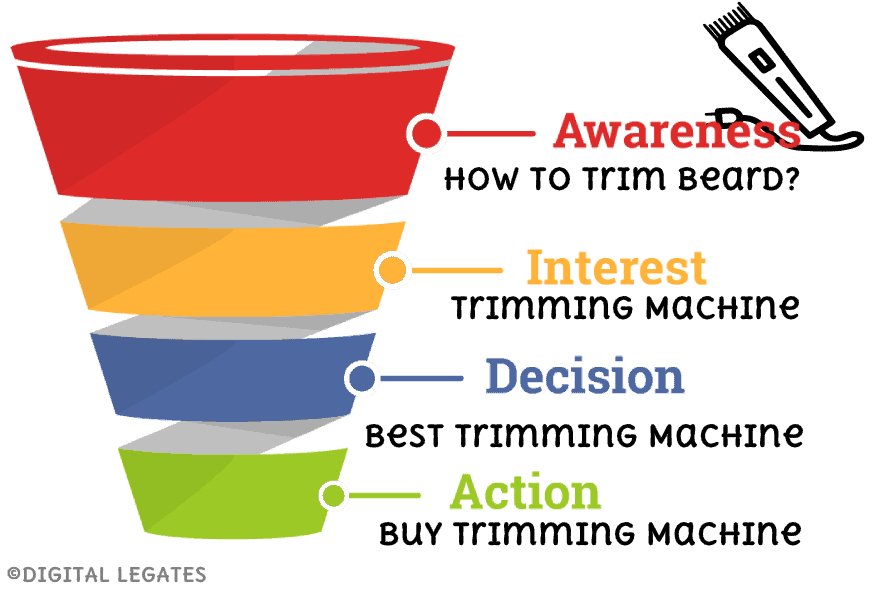In this article, we are going to move on to Keyword Planning using the AIDA funnel and take a deeper look at it. Now there is a lot of things we want to understand regarding targeted keyword or peripheral keywords. Moreover, we also want to understand the estimated volume and estimated cost for our keyword.
But first thing first, in this article what we are going to do is to start by properly understanding the buyer’s funnel also known as the sales funnel, and also known as the AIDA funnel.
So in order to understand the difference between the intent behind different search terms, we need to take a closer look at how a funnel looks like, how we need to do planning to understand where they are in the funnel, and then we are able to systematically organize them off to that. So if this sounds like gibberish, then don’t worry this article ahead will make things clear.
Take a closer look at AIDA Buyers Funnel
So what we are using is the AIDA funnel for planning keywords. A – Awareness, I – Interest, D- Desire, A – ActionKeyword Planning Using AIDA FunnelAnd the theory behind this funnel is that every single person who ever purchased anything or ever got in any service or whatever always went through this tunnel.

But in order to properly understand the different steps for Keyword Planning using AIDA Funnel. Let’s break them down one by one.
Awareness
The awareness stage is a problem to the solution part, we like to call this the logical part. So basically, a customer comes over a search engine with certain search term looking for a solution to their problem. And at this stage of the funnel, you as a brand or service provider offer them a solution, or rather this is where you match your keywords as the solution to the searcher problem.
Now this is very high up in the funnel and generally, this is much harder to convert into actual purchases, and the reason for that is because they are not emotionally invested yet. They might understand logically that okay this should be a good idea for me, but they don’t have any emotional investment and they haven’t been sold on the idea yet.
Most of the time, the best way to handle this top of the funnel customer is to send them to pages with educational content. But since they are so far up in the funnel as well, the cost per click tends to be very low. If we do a good job with our research, we might actually end up finding the really solid top of the funnel keywords that we pay minimal but have some great conversions.
And in the end, what is we are looking at well, that would be profit. It is all about profit in the end. So don’t worry about low rate conversion as long as we are getting good profit.
Interest
The “interest” part is where the customer actually feel they want something. Now the “want” is where the emotional part starts to kick in. They want this for some of their actual connection and actions. And the interesting part is usually generating desire. For example, where things such as “How to get easy coffee in the morning?” The solution to that would be the availability of espresso machines. Most of the time after understanding the solution the user suddenly turns into a customer who wants the solution.
Emotional interest wanting the solution, this is where emotional part kicks in, that’s usually when they stay much higher probability towards a buying intent.
That means already they jump in Cost Per Click between awareness and interest tend to be quite big. Since the customer is showing interest in the product already and those kinds of keywords are quite popular. But still, they are nothing when it comes to cost comparison of Desire and especially not of action because those are going to have a much higher conversion, but also much higher costs.
So far we have understood that awareness is the logical part, where a customer comes with a problem and they get aware of the solution, and then they come to the interest where they get emotionally involved in getting the product and service. The next step we have
Desire
Desire is when the customer actually starts actively looking for that product, that doesn’t mean they are going to buy the product but they may be looking for them.
This is a really great part to bombard the audience with sales, and discounts, and prices. Because, usually when there is a desire and they are actively looking, and if they are getting a good reason to buy the product like “Hey this is only going to be on sale for next seven-hour, is now or never deal you can make it on 30% discount”.
This is usually enough to push them over the edge at this point. But actively looking also doesn’t mean that they are going to buy now. Actively looking might also mean, they are comparing prices, that they are looking for a certain color, and they are just doing the research.
But what is for sure at this level, is that they found a solution, and they really want it, and now they are doing something to search that product or service out. There is actually something going on at this level. And finally, let’s go down to Action.
Action
Action is usually called buying intent. This is the bottom of the funnel and the customer is going to take action. Here the customer is ready to make a purchase, for example, the search terms saying “Buy a magazine” “Buy a pant” “Buy a Mobile”. Almost every keyword with buying intent placed over the search queries shows that the customer has decided on the product they are going to buy.
At this moment you realize that by all means customer intent is black and white making them a very lucrative customer. Search volume for keywords under the action section of the AIDA funnel is high, so clearly the CPC is going to be the highest. Ahead in this article, we will also learn how Keyword Planning Using AIDA funnel helps the business and how it functions. So let’s check
How is Keyword Planning Using Buyers Funnel Works?
Let’s understand it with a graphical representation of a buyer’s journey. Here we are creating an AIDA funnel for a product. The product which we are taking as a reference is a “Trimming Machine”.

Awareness Via Solution To A Problem
If an online user searches over the internet, a key phrase “How to Trim Beard?” google will offer the searcher with a solution as a link to a web portal or to some blog posts that are sharing information on Grooming and Skincare. Let’s say the article or video makes the searcher aware of the trimming tool which they can use for the purpose of grooming. This condition will come under segment Awareness of the funnel.
Interest Shows What Customer Wants
But as the user now understand how to trim. Then the very next thing the user will search over the internet is “Use of Trimming Machine”. This means that the searcher is now getting interested to learn more about the trimming tools available. This condition will fall under the section Interest of the AIDA Funnel.
Desire Makes User To Look for Product
Moving ahead, now the searchers know the functioning of the trimming machine and are compelled to have one for personal use. The very next keyword which the user will search most probably will be “Best Trimming Machine For Personal Use”. These kinds of key phrases often land in the section Desire of the funnel. Where the user is now more involved in selecting the best trimming machine to use.
Final Decision of Buying the Product
Now the final thing which the online user may search is “Buy Trimming Machine” or “Affordable Trimming Machine” or “X Brand Trimming Machine” where X is for different kinds of brands the user may have encountered in previous searches while learning about trimming machine. These forms of keywords give high chances of conversion. Where the user is on the verge of buying a product. Hence the keyword costs are going to be a bit high and they are covered under the segment Action of AIDA model.
Bottom Line for Keyword Panning As Per Buyers Funnel
As a Digital Marketing Service Provider, we recommend clients put some of their resources in Keyword Planning using AIDA Funnel. Because this is where you are going to maximize the rate of conversions. However, the sweet spots are still going to be higher up in the funnel where you need to pay less but you will be having high profits. Collaborating search engine optimization and content marketing at the same time gives wonderful sales results. Even more, social media can also play a role when it comes to generating awareness regarding products and services.
Again, in short, we are breaking this AIDA funnel down from top to the bottom,
From the top we understand, they have a problem, they get a solution or this perfectly logical understanding, but they don’t really care at this point. “They” are used here for representing the online audience making the searches.
The next stop is that they start to want; they start to become emotionally interested and engaged with the product or services.
And then there is the desire, they actually want it so they start looking for it.
Afterward, it’s the action where they pull out wallets and cards with the intent of buying the product. The action phase is the biggest phase. It brings the most sale and covers the ability to convert the audience to customers.
So why we are breaking down the funnel like this? Well, because we are going to group our keywords by the funnel level. The funnel helps us to understand the ways of organizing keywords. We need to understand there are lots of different ways to organize keywords.
But one of the ways is going to be planning keywords around different levels of the funnel. And manage the budget in such ways that the profit can be maximized.



